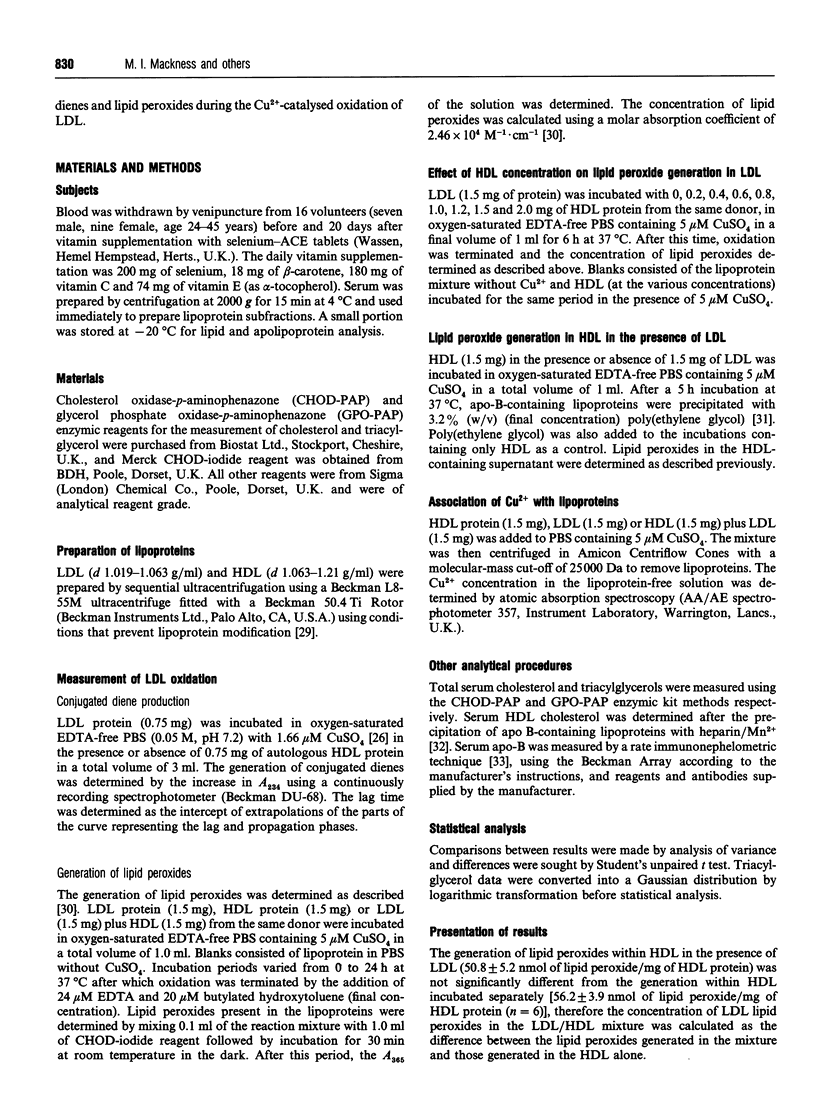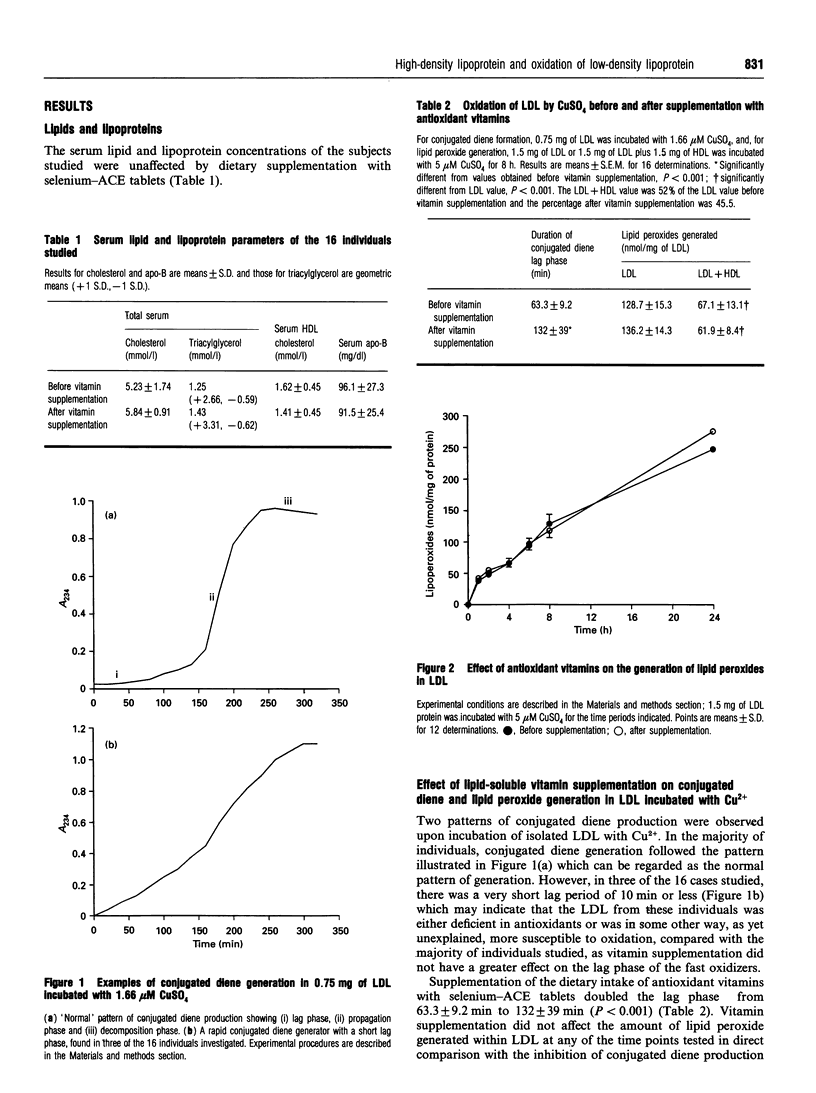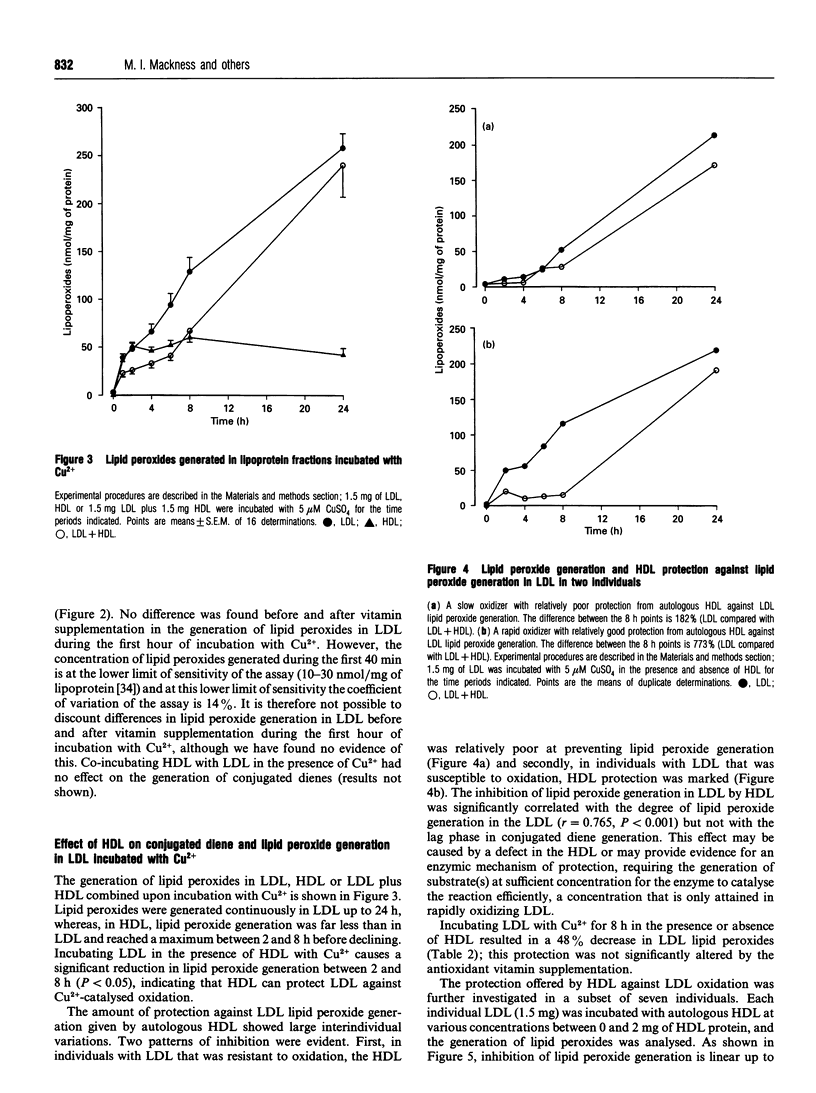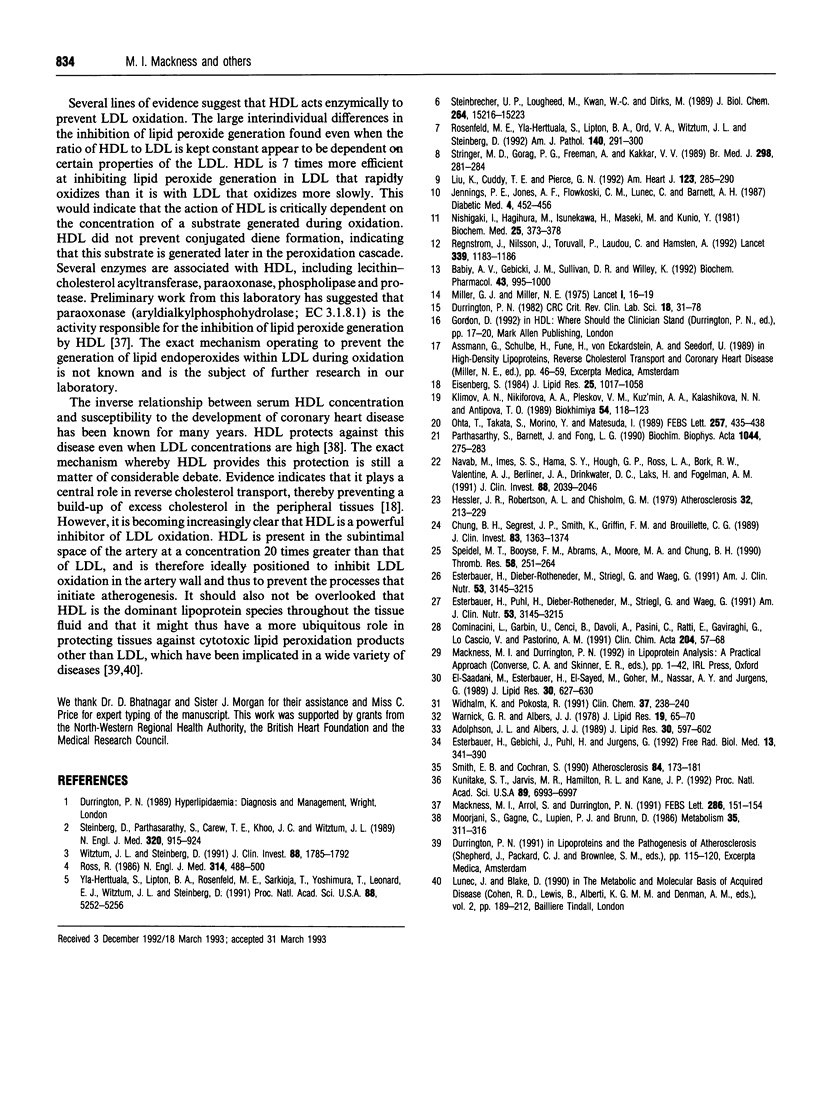Abstract
1. The oxidation of low-density lipoprotein (LDL) is believed to play a central role in atherogenesis. We have compared the effect of antioxidant vitamins and high-density lipoprotein (HDL) on the Cu(2+)-catalysed oxidation of LDL. 2. Antioxidant vitamin supplementation significantly reduced conjugated diene formation but did not affect the formation of lipid peroxides. 3. Conversely, HDL did not affect conjugated diene formation but inhibited the formation of lipid peroxides by up to 90%. 4. The inhibition by HDL of lipid peroxide formation in oxidized LDL was dependent on the concentration of HDL and was not due to HDL chelating Cu2+. 5. Large interindividual variations in the inhibition of lipid peroxide formation by autologous HDL were evident, which were related to the rate of lipid peroxide generation in the LDL. 6. We conclude that HDL is a powerful antioxidant or more probably inhibitor of LDL oxidation in vitro and may play an important role in vivo in preventing atherosclerosis by inhibiting LDL oxidation in the artery wall.
Full text
PDF





Selected References
These references are in PubMed. This may not be the complete list of references from this article.
- Adolphson J. L., Albers J. J. Comparison of two commercial nephelometric methods for apoprotein A-I and apoprotein B with standardized apoprotein A-I and B radioimmunoassays. J Lipid Res. 1989 Apr;30(4):597–606. [PubMed] [Google Scholar]
- Babiy A. V., Gebicki J. M., Sullivan D. R., Willey K. Increased oxidizability of plasma lipoproteins in diabetic patients can be decreased by probucol therapy and is not due to glycation. Biochem Pharmacol. 1992 Mar 3;43(5):995–1000. doi: 10.1016/0006-2952(92)90604-h. [DOI] [PubMed] [Google Scholar]
- Chung B. H., Segrest J. P., Smith K., Griffin F. M., Brouillette C. G. Lipolytic surface remnants of triglyceride-rich lipoproteins are cytotoxic to macrophages but not in the presence of high density lipoprotein. A possible mechanism of atherogenesis? J Clin Invest. 1989 Apr;83(4):1363–1374. doi: 10.1172/JCI114024. [DOI] [PMC free article] [PubMed] [Google Scholar]
- Cominacini L., Garbin U., Cenci B., Davoli A., Pasini C., Ratti E., Gaviraghi G., Lo Cascio V., Pastorino A. M. Predisposition to LDL oxidation during copper-catalyzed oxidative modification and its relation to alpha-tocopherol content in humans. Clin Chim Acta. 1991 Dec 31;204(1-3):57–68. doi: 10.1016/0009-8981(91)90217-z. [DOI] [PubMed] [Google Scholar]
- Durrington P. N. High-density lipoprotein cholesterol: methods and clinical significance. Crit Rev Clin Lab Sci. 1982;18(1):31–78. doi: 10.3109/10408368209082589. [DOI] [PubMed] [Google Scholar]
- Eisenberg S. High density lipoprotein metabolism. J Lipid Res. 1984 Oct;25(10):1017–1058. [PubMed] [Google Scholar]
- Esterbauer H., Gebicki J., Puhl H., Jürgens G. The role of lipid peroxidation and antioxidants in oxidative modification of LDL. Free Radic Biol Med. 1992 Oct;13(4):341–390. doi: 10.1016/0891-5849(92)90181-f. [DOI] [PubMed] [Google Scholar]
- Hessler J. R., Robertson A. L., Jr, Chisolm G. M., 3rd LDL-induced cytotoxicity and its inhibition by HDL in human vascular smooth muscle and endothelial cells in culture. Atherosclerosis. 1979 Mar;32(3):213–229. doi: 10.1016/0021-9150(79)90166-7. [DOI] [PubMed] [Google Scholar]
- Jennings P. E., Jones A. F., Florkowski C. M., Lunec J., Barnett A. H. Increased diene conjugates in diabetic subjects with microangiopathy. Diabet Med. 1987 Sep-Oct;4(5):452–456. doi: 10.1111/j.1464-5491.1987.tb00908.x. [DOI] [PubMed] [Google Scholar]
- Klimov A. N., Nikiforova A. A., Pleskov V. M., Kuz'min A. A., Kalashnikova N. N. Zashchitnoe deistvie lipoproteidov vysokoi plotnosti, ikh podfraktsii i letsitin-kholesterin-atsiltransferazy v perekisnoi modifikatsii lipoproteidov nizkoi plotnosti. Biokhimiia. 1989 Jan;54(1):118–123. [PubMed] [Google Scholar]
- Kunitake S. T., Jarvis M. R., Hamilton R. L., Kane J. P. Binding of transition metals by apolipoprotein A-I-containing plasma lipoproteins: inhibition of oxidation of low density lipoproteins. Proc Natl Acad Sci U S A. 1992 Aug 1;89(15):6993–6997. doi: 10.1073/pnas.89.15.6993. [DOI] [PMC free article] [PubMed] [Google Scholar]
- Liu K. Z., Cuddy T. E., Pierce G. N. Oxidative status of lipoproteins in coronary disease patients. Am Heart J. 1992 Feb;123(2):285–290. doi: 10.1016/0002-8703(92)90636-a. [DOI] [PubMed] [Google Scholar]
- Mackness M. I., Arrol S., Durrington P. N. Paraoxonase prevents accumulation of lipoperoxides in low-density lipoprotein. FEBS Lett. 1991 Jul 29;286(1-2):152–154. doi: 10.1016/0014-5793(91)80962-3. [DOI] [PubMed] [Google Scholar]
- Miller G. J., Miller N. E. Plasma-high-density-lipoprotein concentration and development of ischaemic heart-disease. Lancet. 1975 Jan 4;1(7897):16–19. doi: 10.1016/s0140-6736(75)92376-4. [DOI] [PubMed] [Google Scholar]
- Moorjani S., Gagné C., Lupien P. J., Brun D. Plasma triglycerides related decrease in high-density lipoprotein cholesterol and its association with myocardial infarction in heterozygous familial hypercholesterolemia. Metabolism. 1986 Apr;35(4):311–316. doi: 10.1016/0026-0495(86)90146-0. [DOI] [PubMed] [Google Scholar]
- Navab M., Imes S. S., Hama S. Y., Hough G. P., Ross L. A., Bork R. W., Valente A. J., Berliner J. A., Drinkwater D. C., Laks H. Monocyte transmigration induced by modification of low density lipoprotein in cocultures of human aortic wall cells is due to induction of monocyte chemotactic protein 1 synthesis and is abolished by high density lipoprotein. J Clin Invest. 1991 Dec;88(6):2039–2046. doi: 10.1172/JCI115532. [DOI] [PMC free article] [PubMed] [Google Scholar]
- Nishigaki I., Hagihara M., Tsunekawa H., Maseki M., Yagi K. Lipid peroxide levels of serum lipoprotein fractions of diabetic patients. Biochem Med. 1981 Jun;25(3):373–378. doi: 10.1016/0006-2944(81)90096-x. [DOI] [PubMed] [Google Scholar]
- Ohta T., Takata K., Horiuchi S., Morino Y., Matsuda I. Protective effect of lipoproteins containing apoprotein A-I on Cu2+-catalyzed oxidation of human low density lipoprotein. FEBS Lett. 1989 Nov 6;257(2):435–438. doi: 10.1016/0014-5793(89)81590-x. [DOI] [PubMed] [Google Scholar]
- Parthasarathy S., Barnett J., Fong L. G. High-density lipoprotein inhibits the oxidative modification of low-density lipoprotein. Biochim Biophys Acta. 1990 May 22;1044(2):275–283. doi: 10.1016/0005-2760(90)90314-n. [DOI] [PubMed] [Google Scholar]
- Regnström J., Nilsson J., Tornvall P., Landou C., Hamsten A. Susceptibility to low-density lipoprotein oxidation and coronary atherosclerosis in man. Lancet. 1992 May 16;339(8803):1183–1186. doi: 10.1016/0140-6736(92)91129-v. [DOI] [PubMed] [Google Scholar]
- Rosenfeld M. E., Ylä-Herttuala S., Lipton B. A., Ord V. A., Witztum J. L., Steinberg D. Macrophage colony-stimulating factor mRNA and protein in atherosclerotic lesions of rabbits and humans. Am J Pathol. 1992 Feb;140(2):291–300. [PMC free article] [PubMed] [Google Scholar]
- Ross R. The pathogenesis of atherosclerosis--an update. N Engl J Med. 1986 Feb 20;314(8):488–500. doi: 10.1056/NEJM198602203140806. [DOI] [PubMed] [Google Scholar]
- Smith E. B., Cochran S. Factors influencing the accumulation in fibrous plaques of lipid derived from low density lipoprotein. II. Preferential immobilization of lipoprotein (a) (Lp(a)). Atherosclerosis. 1990 Oct;84(2-3):173–181. doi: 10.1016/0021-9150(90)90088-z. [DOI] [PubMed] [Google Scholar]
- Speidel M. T., Booyse F. M., Abrams A., Moore M. A., Chung B. H. Lipolyzed hypertriglyceridemic serum and triglyceride-rich lipoprotein cause lipid accumulation in and are cytotoxic to cultured human endothelial cells. High density lipoproteins inhibit this cytotoxicity. Thromb Res. 1990 May 1;58(3):251–264. doi: 10.1016/0049-3848(90)90095-t. [DOI] [PubMed] [Google Scholar]
- Steinberg D., Parthasarathy S., Carew T. E., Khoo J. C., Witztum J. L. Beyond cholesterol. Modifications of low-density lipoprotein that increase its atherogenicity. N Engl J Med. 1989 Apr 6;320(14):915–924. doi: 10.1056/NEJM198904063201407. [DOI] [PubMed] [Google Scholar]
- Steinbrecher U. P., Lougheed M., Kwan W. C., Dirks M. Recognition of oxidized low density lipoprotein by the scavenger receptor of macrophages results from derivatization of apolipoprotein B by products of fatty acid peroxidation. J Biol Chem. 1989 Sep 15;264(26):15216–15223. [PubMed] [Google Scholar]
- Stringer M. D., Görög P. G., Freeman A., Kakkar V. V. Lipid peroxides and atherosclerosis. BMJ. 1989 Feb 4;298(6669):281–284. doi: 10.1136/bmj.298.6669.281. [DOI] [PMC free article] [PubMed] [Google Scholar]
- Warnick G. R., Albers J. J. A comprehensive evaluation of the heparin-manganese precipitation procedure for estimating high density lipoprotein cholesterol. J Lipid Res. 1978 Jan;19(1):65–76. [PubMed] [Google Scholar]
- Widhalm K., Pakosta R. Precipitation with polyethylene glycol and density-gradient ultracentrifugation compared for determining high-density lipoprotein subclasses HDL2 and HDL3. Clin Chem. 1991 Feb;37(2):238–240. [PubMed] [Google Scholar]
- Witztum J. L., Steinberg D. Role of oxidized low density lipoprotein in atherogenesis. J Clin Invest. 1991 Dec;88(6):1785–1792. doi: 10.1172/JCI115499. [DOI] [PMC free article] [PubMed] [Google Scholar]
- Ylä-Herttuala S., Lipton B. A., Rosenfeld M. E., Särkioja T., Yoshimura T., Leonard E. J., Witztum J. L., Steinberg D. Expression of monocyte chemoattractant protein 1 in macrophage-rich areas of human and rabbit atherosclerotic lesions. Proc Natl Acad Sci U S A. 1991 Jun 15;88(12):5252–5256. doi: 10.1073/pnas.88.12.5252. [DOI] [PMC free article] [PubMed] [Google Scholar]
- el-Saadani M., Esterbauer H., el-Sayed M., Goher M., Nassar A. Y., Jürgens G. A spectrophotometric assay for lipid peroxides in serum lipoproteins using a commercially available reagent. J Lipid Res. 1989 Apr;30(4):627–630. [PubMed] [Google Scholar]


